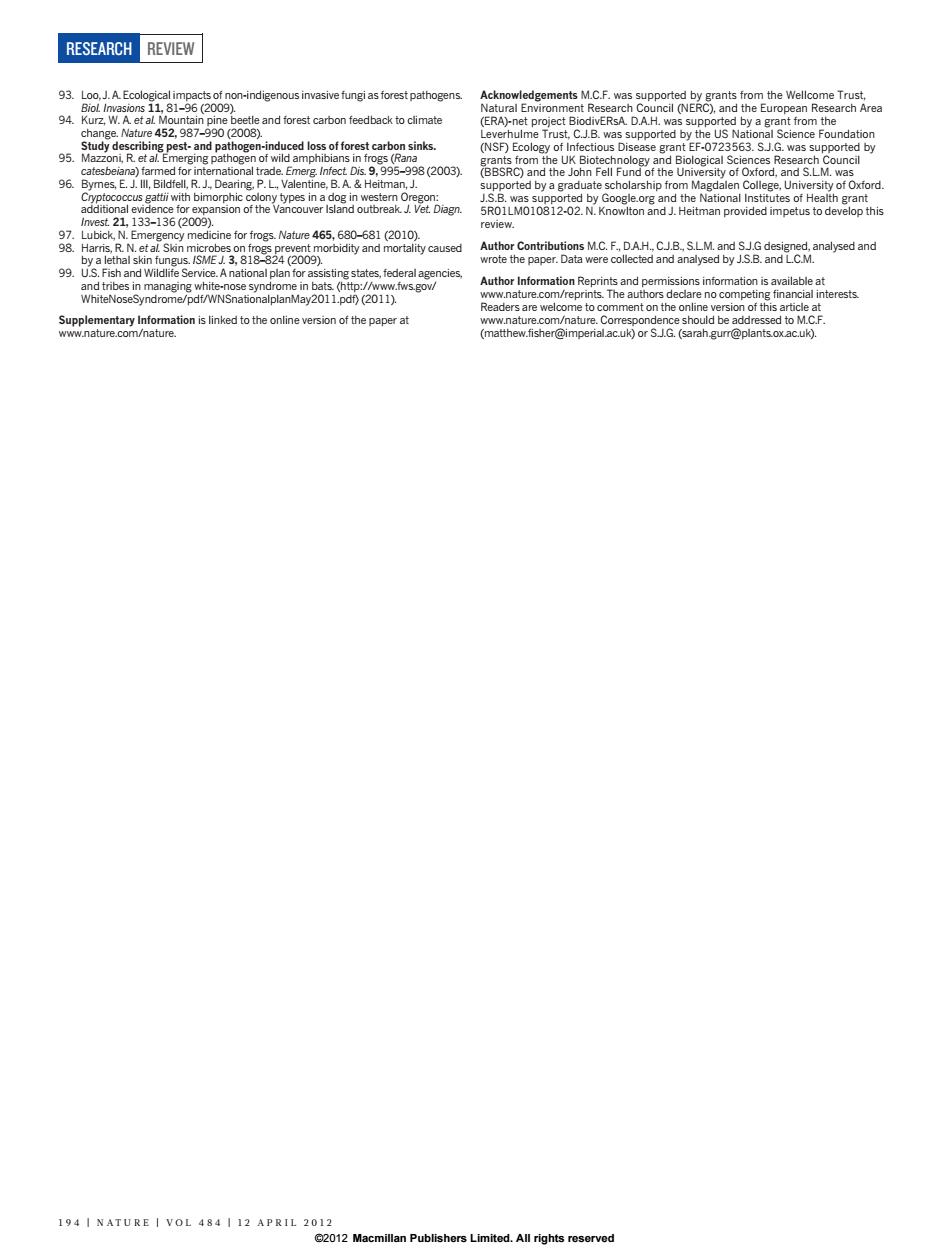正在加载图片...

RESEARCH REVIEW 93.Loo,J.A Ecological impacts of non-indigenous invasive fungi as forest pathogens. Acknowledgements M.C.F.was supported by grants from the Wellcome Trust, Biol Invasions 11,81-96(2009). Natural Environment Research Council (NERC),and the European Research Area 94.Kurz,W.A.et al Mountain pine beetle and forest carbon feedback to climate (ERA)-net project BiodivERsA.D.A.H.was supported by a grant from the change.Nature452,987-990(2008). Leverhulme Trust,C.J.B.was supported by the US National Science Foundation Study describing pest-and pathogen-induced loss of forest carbon sinks. (NSF)Ecology of Infectious Disease grant EF-0723563.S.J.G.was supported by 95.Mazzoni,R.et al.Emerging pathogen of wild amphibians in frogs (Rana grants from the UK Biotechnology and Biological Sciences Research Council catesbeiana)farmed for international trade.Emerg.Infect Dis.9,9999(2003). (BBSRC)and the John Fell Fund of the University of Oxford,and S.L.M.was 96.Bymes,E.J.Il,Bildfell,R.J.Dearing.P.L.,Valentine,B.A.Heitman,J. supported by a graduate scholarship from Magdalen College,University of Oxford Cryptococcus gattii with bimorphic colony types in a dog in western Oregon: J.S.B.was supported by Google.org and the National Institutes of Health grant additional evidence for expansion of the Vancouver Island outbreak.J.Vet.Diagn. 5R01LM010812-02.N.Knowlton and J.Heitman provided impetus to develop this west21,133-136(2009) review. 97.Lubick,N.Emergency medicine for frogs.Nature 465,680-681 (2010). 98.Harris,R.N.etal Skin microbeson frogs prevent morbidity and mortality caused Author Contributions M.C.F.,D.A.H.,C.J.B.,S.LM.and SJ.G designed,analysed and by a lethal skin fungus.ISME J.3,818-824(2009). wrote the paper.Data were collected and analysed by J.S.B.and L.C.M. 99.U.S.Fish and Wildlife Service.A national plan for assisting states,federal agencies and tribes in managing white-nose syndrome in bats.(http://www.fws.gov/ Author Information Reprints and permissions information is available at WhiteNoseSyndrome/pdf/WNSnationalplanMay2011.pdf)(2011). www.nature.com/reprints.The authors declare no competing financial interests Readers are welcome to comment on the online version of this article at Supplementary Information is linked to the online version of the paper at www.nature.com/nature.Correspondence should be addressed to M.C.F www.nature.com/nature. (matthew.fisher@imperial.ac.uk)or S.J.G.(sarah.gur@plants.ox.ac.uk). 194 NATURE VOL 48412 APRIL 2012 2012 Macmillan Publishers Limited.All rights reserved93. Loo, J. A. Ecological impacts of non-indigenous invasive fungi as forest pathogens. Biol. Invasions 11, 81–96 (2009). 94. Kurz, W. A. et al. Mountain pine beetle and forest carbon feedback to climate change. Nature 452, 987–990 (2008). Study describing pest- and pathogen-induced loss of forest carbon sinks. 95. Mazzoni, R. et al. Emerging pathogen of wild amphibians in frogs (Rana catesbeiana) farmed for international trade. Emerg. Infect. Dis. 9, 995–998 (2003). 96. Byrnes, E. J. III, Bildfell, R. J., Dearing, P. L., Valentine, B. A. & Heitman, J. Cryptococcus gattii with bimorphic colony types in a dog in western Oregon: additional evidence for expansion of the Vancouver Island outbreak. J. Vet. Diagn. Invest. 21, 133–136 (2009). 97. Lubick, N. Emergency medicine for frogs. Nature 465, 680–681 (2010). 98. Harris, R. N. et al. Skin microbes on frogs prevent morbidity and mortality caused by a lethal skin fungus. ISME J. 3, 818–824 (2009). 99. U.S. Fish and Wildlife Service. A national plan for assisting states, federal agencies, and tribes in managing white-nose syndrome in bats. Æhttp://www.fws.gov/ WhiteNoseSyndrome/pdf/WNSnationalplanMay2011.pdfæ (2011). Supplementary Information is linked to the online version of the paper at www.nature.com/nature. Acknowledgements M.C.F. was supported by grants from the Wellcome Trust, Natural Environment Research Council (NERC), and the European Research Area (ERA)-net project BiodivERsA. D.A.H. was supported by a grant from the Leverhulme Trust, C.J.B. was supported by the US National Science Foundation (NSF) Ecology of Infectious Disease grant EF-0723563. S.J.G. was supported by grants from the UK Biotechnology and Biological Sciences Research Council (BBSRC) and the John Fell Fund of the University of Oxford, and S.L.M. was supported by a graduate scholarship from Magdalen College, University of Oxford. J.S.B. was supported by Google.org and the National Institutes of Health grant 5R01LM010812-02. N. Knowlton and J. Heitman provided impetus to develop this review. Author Contributions M.C. F., D.A.H., C.J.B., S.L.M. and S.J.G designed, analysed and wrote the paper. Data were collected and analysed by J.S.B. and L.C.M. Author Information Reprints and permissions information is available at www.nature.com/reprints. The authors declare no competing financial interests. Readers are welcome to comment on the online version of this article at www.nature.com/nature. Correspondence should be addressed to M.C.F. (matthew.fisher@imperial.ac.uk) or S.J.G. (sarah.gurr@plants.ox.ac.uk). RESEARCH REVIEW 194 | NATURE | VOL 484 | 12 APR IL 2012 ©2012 Macmillan Publishers Limited. All rights reserved